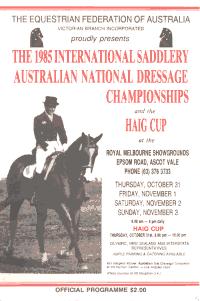|
|
|||
|
||||
| Information from the
Program - About this competition. FEI World Dressage Challenge – A Potted History! And The FEI Code of Conduct
This event was set up to give less experienced Dressage Riders in the more remote countries of the world, who under normal circumstances, cannot take part in International Dressage competitions, the opportunity to compete internationally, without having to leave their own country. The countries are grouped, and the FEI chooses two international judges to travel to each country within the group so that all the riders are seen by the same judges. After each competition the judges give a compulsory training clinic with the riders they have judged. The original countries in the group to which Australia belongs were Japan, Australia, New Zealand. Over the years, countries such as Korea, South Africa, Israel and Japan have been added and deleted, but Australia and New Zealand have remained constant. In 1999, 37 countries with a total of 372 competitors took part in this competition. A new formula introduced in 1998 ie the possibility to run Prix St. Georges and Elementary tests in every country was well supported and a Competition for Children from 12 – 14 was also introduced involving 85 competitors over 17 countries. In 2000, 43 countries will participate in nine groups. Our group consists of Hong Kong, Chinese Taipei, New Zealand and Australia. A Team classification (a team of four riders) and an individual classification is made. The Team members are designated prior to the competition. Australia has participated in every competition since 1986, and in 1987 Australia won both the Team and Individual classification. The competition level chosen is Prix St. Georges. In 1996 the Australian qualifying process rules were changed to provide for 5-6 qualifying competitions in each State, and also a State Final. At the State Final, the horses of the riders are required to participate in a fitness inspection (trot up) prior to the actual competition, at which the horse’s ID papers (or Passport – not the EFA registration papers) are checked and each horse must be confirmed sound to compete. The trot up is an integral part of all international competitions, as is part of the procedure at this Australian Final that took place on Sunday November 26, 2000. The FEI have announced that from January 1st. 2001 the German company Performance Sales International (PSI) will sponsor the Dressage Challenge. The Challenge has significantly contributed to the development of dressage in Australia. FEI Code of Conduct.
|
||||
About the Competition & FEI Code of Conduct | The Judges |
||||




 2000 sees the World Dressage Challenge in
its 19th. Year of existence generously supported by HAIG from 1982 – 1987
and SAMSUNG ELECTRONICS from 1988 – 1996. In 1997 the FEI (Federation Equestre
Internationale) – the International controlling body for equestrian sports took over
the financial responsibility for the competition and this is the fourth year there has
been no global sponsorship. Pictured right the cover of the program of the 1985 Haig
Cup with a picture of Australian/International combination Margaret McIver on CK.
2000 sees the World Dressage Challenge in
its 19th. Year of existence generously supported by HAIG from 1982 – 1987
and SAMSUNG ELECTRONICS from 1988 – 1996. In 1997 the FEI (Federation Equestre
Internationale) – the International controlling body for equestrian sports took over
the financial responsibility for the competition and this is the fourth year there has
been no global sponsorship. Pictured right the cover of the program of the 1985 Haig
Cup with a picture of Australian/International combination Margaret McIver on CK.